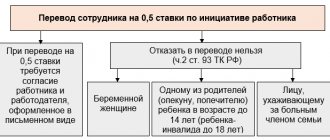In accordance with the order of the Ministry of Transport of the Russian Federation No. 59 dated March 11, 2021:
3.1. Driver training includes instruction and practice.
3.2. The briefing is carried out to provide the driver with information about the specifics of performing labor functions related to the transportation of passengers and cargo. The briefing is combined with additional testing of drivers’ knowledge and skills for compliance with qualification requirements.
3.3. The practice is carried out to confirm the compliance of the driver’s skills with the qualification requirements for independent driving of a specific vehicle under the control of a driver-mentor and includes driving a vehicle without leaving and driving on public roads.
3.4. For drivers of route vehicles, practical driving of a vehicle on public roads includes driving along a route without passengers and with passengers.
3.5. The number of internship hours is set by the employer
Who is eligible for the internship and what are its goals?
Order for permission to work independently
Drivers who have no work experience, transferred from one type of transport to another, or if their work in this position had a break of more than twelve months, are required to undergo an internship. The purpose of this procedure is to improve the acquired knowledge and skills that ensure safe driving on the roads, and the ability to apply them in specific conditions. Order of the Ministry of Transport No. 59 entrusts the employer with conducting an internship; the latter issues an order for the enterprise, appoints a mentor and the required number of hours.
Driver internship program.
5.1. Briefing. Theoretical part of the internship. Testing professional knowledge.
5.1.1. Repetition and self-learning.
For all categories of drivers subject to internship, the employer provides the opportunity to:
— repeat the rules of the road;
— study vehicle operating manuals, including features of braking systems and steering;
— study the manuals for the design and operation of special equipment installed on vehicles (if the driver will service this equipment);
— study the rules for operating tires and batteries;
— study the rules for placing and securing cargo;
— study the rules for transporting passengers in cars, buses, trolleybuses and trams;
- study the rules for transporting mechanics - repairmen in bodies - vans;
— study fire safety rules on vehicles;
— learn that you can’t use your phone while driving while holding it in your hand.
We recommend that you read the description of technical means that allow you to negotiate on the phone without using your hands.
5.1.2. Knowledge testing on the theoretical part of driver training, after repetition and training, is carried out by a specialist of the subject of transport activity, responsible for ensuring road safety.
5.1.3. The duration of the internship, its theoretical part together with the knowledge test, can practically range from one to three work shifts.
Practical part of the internship.
6.1. Internships for driving course graduates and current drivers are carried out under the direct supervision of a driver-mentor.
A driver-mentor can be appointed from the staff of a legal entity or individual entrepreneur, or brought in from outside.
The requirements for a driver mentor are set out in paragraph 16 of Order No. 59 of the Ministry of Transport of the Russian Federation dated March 11, 2021 and they are as follows:
- have not had any traffic accidents due to your fault in the last year of work;
- have at least three years of work experience (experience) on the relevant type of vehicle (with an internship in a passenger taxi or truck);
- have at least five years of experience working on the relevant type of vehicle (with an internship on a bus, tram or trolleybus).
The mentor driver must always be in the vehicle next to the trainee.
6.2. Driving vehicles without entering public roads.
In the territories of subjects of transport activity (in-park areas), trainees, under the guidance of a driver-mentor, carry out the following actions:
a) study in practice the controls and features of the design and operation of the vehicle, as well as the special equipment installed on it;
b) study the traffic pattern on the territory of subjects of transport activity;
c) duplicate the application of practical techniques used in the management, maintenance and operation of a vehicle;
d) operate in internal territories passenger cars and trucks (special vehicles) and vehicles for the transport of passengers (buses, trolleybuses and trams) without passengers.
The duration of the internal parking internship is one work shift (recommendation).
6.3. Internship on cars and trucks on public roads.
Save link to:
I’ll add my own fly in the ointment regarding the programs: Topic 2 “Labor Safety Legislation” reflects only one document from the entire complex of legislative acts - this is the Labor Code of the Russian Federation. Therefore, all content in this section applies only to him. In topic 3 “Regulatory documents on labor protection”, rules, norms, and standard instructions are regulatory legal acts on labor protection that establish state regulatory requirements for labor protection, unlike the rest. And these regulations should be considered together with Section 2 of the Labor Code of the Russian Federation, since many of them relate to the subject of this section: Providing workers with personal protective equipment. The procedure for issuing milk or other equivalent food products to employees. Working hours and rest time. Length of the working week, daily work (shift), start and end times of work, time of breaks in work, number of shifts per day, alternation of working and non-working days. Shift work. Overtime and its limitations. Types of rest time. Breaks for rest and food. Duration of weekly uninterrupted rest. Annual paid holidays and their duration. Annual additional paid leave, Special assessment of working conditions. Topic 4 indicates the state management of occupational safety and health, but does not even mention the OSMS in the organization, which is currently a particularly pressing task. In topic 5: - repeated instruction is correctly called repeated in the workplace; i.e. it is better to write initial and repeated briefings at the workplace; — training in safe methods and techniques for performing work with on-the-job training is carried out for all workers who receive initial instruction at the workplace, and not just people entering work in harmful and (or) dangerous working conditions, but knowledge testing in in the first case it is carried out in the form of a survey of the person being instructed by the instructing person, and in the second case - in the form of an exam; Accordingly, their forms of education are different;
You want information, but you do it without respect
Greetings, dear friends! I’ll open the first spring day on the Blog with a powerful note, like a Gelendvagen from Mercedes-Benz, with free material - occupational safety training programs with exam cards for drivers driving different types of vehicles!
- Testing the theoretical knowledge possessed by a trainee driver. Questions are asked both on the rules of operation and design of the type of vehicle on which it will work, and on the general rules of driving, behavior on the road, etc. In total, at least 20 questions are asked.
- Driving a car on a special platform. Here the trainee must demonstrate that he is able to at least minimally drive a new vehicle. If he fails at this stage, he is suspended, is considered to have failed the internship and cannot be allowed to work independently.
- A trip along a future route (for minibuses) or just around the city with a driver-mentor. The trainee must be behind the wheel, but the mentor has the right to exclude him from driving on difficult sections. A note about the suspension is made on the internship card.
- Control flight along the route with cargo or passengers under the guidance of a mentor. This is a kind of final exam during which the driver-mentor does not interfere with driving, but only notes the behavior and skills of the trainee.
The second norm has a somewhat unusual status. This is the guiding document RD-200-RSFSR-12-0071-86-12, adopted by the Ministry of Motor Transport of the RSFSR back in 1986. Formally, it is not binding, since it has not been officially published, but this document describes in detail the rules by which driver training is carried out, so many enterprises prefer to use it. True, in order for the RD to be applied, either its norms must be enshrined in the internal acts of the organization, or these acts must contain a reference to the RD.
This is interesting: Are payments possible mmm 2021
Regulations on internships for drivers
In order to conduct an internship correctly and legally, it is necessary to be guided by a number of regulations. The first of these is the Labor Code. Relevant to internships are those rules that relate to the probationary period when concluding an employment contract. The fact is that the internship is framed as a test. At the same time, it must be indicated in the text of the employment contract - otherwise, an employee who has completed the internship unsatisfactorily cannot be refused employment.
A control check is necessary to assess the driver’s professional skills; it is carried out using test questions from the internship program. The practical part of the internship is assessed through a control test of driving skills. The worker is tested in real conditions of movement along the route and the slightest violations are recorded, which are then summarized and conclusions are drawn about the suitability of the worker. At the end of the internship, the driver is given a conclusion allowing him to work, which indicates the type of vehicle and route. The conclusion must be kept in the employee’s personal file.
1.2. Order of the Ministry of Transport of the Russian Federation No. 59 dated March 11, 2016 “On approval of the Procedure for undergoing professional selection and vocational training for employees hired for work directly related to the movement of road transport vehicles and urban ground electric transport.”
Motor transport - rules, norms, regulations
The current version of the document you are interested in is available only in the commercial version of the GARANT system. You can purchase a document for 54 rubles or get full access to the GARANT system free of charge for 3 days.
The regulations on internships and admission to independent work for car drivers contain standards for the duration of internships on actual routes for transporting passengers, depending on the category assigned to them.
Internship for bus drivers is a separate matter, since such work involves a risk to the lives of passengers; not only his life, but also the lives of many people depend on the driver. The trainee begins to drive a bus along a set route assigned to his vehicle and always under the guidance of a mentor.
Upon admission to the bus route
It happens that permission is not issued. Then the person is transferred, by his consent, to other types of work. If the employee is unwilling or unable to transfer to another job, the employee is dismissed under the relevant article of the Labor Code. Drivers who have undergone a pre-trip examination by a doctor are allowed to work on a daily basis. Before leaving, be sure to inspect the bus and check the serviceability of components that ensure traffic safety. Then they receive travel documents and travel along the route according to the established schedule.
As a rule, the company (represented by the director) can amend the existing regulations if the organization has undergone a change in the technological process (or field of activity), but it always contains the main points:
Who is the intern?
- For example, an internship for a passenger car lasts 1 day, and a truck lasts 2 days.
- For beginners, the period can be extended to a month.
- Particular attention is paid to bus drivers , since they are entrusted with human lives on the route. The internship is divided into pre-route and route parts. Beginners in driving are trained for the largest number of hours - more than two hundred.
- Persons who have a minor break in work , as well as those transferred from one bus to another, are trained in the range of 30 to 50 hours of total time.
- Drivers on mountain routes may be assigned an internship of up to three months.
Stages of internship
- The driver gets behind the wheel of a vehicle of this type for the first time;
- Starts working on a new route;
- I have not worked as a driver for more than one year;
- Has no driving experience, just graduated from training;
- He intends to work in difficult mountain conditions, on roads with increased danger.
Familiarization of the employee with the functional structure of the department, the nature and characteristics of the upcoming work, production and technological processes. Practical development of techniques and methods of work activity.
- instructions on labor protection for main and related professions, types of work;
- requirements for the proper organization and maintenance of the workplace and vehicle;
- the procedure for checking the serviceability of equipment, safe preparation and commissioning of the vehicle;
- purpose of control and measuring instruments, as well as blocking, signaling, safety and protective equipment, and devices used during the operation of the vehicle;
- fire safety measures, location and operating principles of fire fighting equipment, etc.;
- methods of preventing and eliminating emergency situations, actions when extinguishing fires, fires, gas contamination;
- the procedure for using collective and individual protective equipment (PPE) and safety devices, requirements for workwear and special footwear;
- rules for providing first aid in case of road accidents, burns, poisoning, electric shock and other accidents.
This is interesting: Property tax deduction at work from what month in 2020
Occupational Safety and Health
If the results of the internship are at least satisfactory, an appropriate decision is made, signed by the head of the organization, and the driver is allowed to drive the car independently. In the same case, if it turns out that the driver did not complete the internship well enough, one of 2 decisions can be made:
When buying a car, all future owners expect to use it without having any problems with the law. The very first step on the path to your cherished dream is: learning to drive and obtaining a license. In Russia, driver's licenses in 2011 changed their form and received additional subcategories. In colloquial slang they were called “new-style rights.”
Additional Information! For enterprises with a high hazard class: the chemical industry, construction, engineering and surveying and other companies subordinate to the Ministry of Construction of Russia, which have not undergone the re-registration procedure, where Rostechnadzor annually monitors the scope of activity for compliance with established requirements, the algorithm for the internship regulations does not change.
Who is eligible for the internship and what are its goals?
If the employee’s work results are negative during the probationary period, the employer has the right to terminate the employment contract with him by notifying him in writing, indicating the reasons that served as the basis for terminating the employment contract (Clause 1, Article 37 of the Labor Code of the Republic of Kazakhstan).
*(3) Registered by the Ministry of Justice of Russia on October 21, 2011, registration No. 22111, as amended by orders of the Ministry of Health and Social Development of the Russian Federation dated May 15, 2013 No. 296n (registered by the Ministry of Justice of Russia on July 3, 2013, registration No. 28970) , dated December 5, 2014 No. 801n (registered by the Ministry of Justice of Russia on February 3, 2015, registration No. 35848).
12. If, based on the results of the interview, the employees’ compliance with the requirements specified in paragraphs 5 - 8 of this Procedure is confirmed, as well as other requirements established in accordance with the labor legislation of the Russian Federation, the employees are hired by legal entities and individual entrepreneurs.
Order of the Ministry of Transport of the Russian Federation dated March 11, 2021 No. 59 “On approval of the Procedure for undergoing professional selection and vocational training for employees hired for work directly related to the movement of vehicles of road transport and urban ground electric transport”
In accordance with subclause 5.2.10.(3) of the Regulations on the Ministry of Transport of the Russian Federation, approved by Decree of the Government of the Russian Federation of July 30, 2004 No. 395 (Collected Legislation of the Russian Federation 2004, No. 32, Art. 3342; 2006, No. 15, Article 1612, No. 24, Article 2601, No. 52 (Part 3), Article 5587, 2008, No. 8, Article 740, No. 11 (Part 1), Article 1029, No. 17, Article 1883 , No. 18, Art. 2060, No. 22, Art. 2576, No. 42, Art. 4825, No. 46, Art. 5337; 2009, No. 3, Art. 378, No. 4, Art. 506, No. 6, Art. 738, No. 13, Article 1558, No. 18 (part 2), Article 2249, No. 32, Article 4046, No. 33, Article 4088, No. 36, Article 4361, No. 51, Article 6332; 2010 , No. 6, Art. 650, Art. 652, No. 11, Art. 1222, No. 12, Art. 1348, No. 13, Art. 1502, No. 15, Art. 1805, No. 25, Art. 3172, No. 26, Art. 6526, No. 47, Art. 6660, No. 48, Art. 6922; 2012, No. 6, Art. 686, No. 14, Art. 1630, No. 19, Art. 2439, No. 44, Art. 6029, No. 49, Art. 6881; 2013, No. 5, Art. 388, No. 12, Art. 1322, No. 26, Art. 3343, No. 33, Art. 4386, No. 38, Art. 4821, No. 45, Art. 5822; 2014, No. 12, art. 1286, No. 18 (part 4), art. 2177, No. 30 (Part 2), Art. 4311, No. 30 (Part 2) Art. 325, No. 37, Art. 4974, No. 42, Art. 5736, No. 43, Art. 5901, art. 5926; 2015, No. 2, art. 491, No. 16, Art. 2394, No. 17 (part 4), art. 2571, No. 20, Art. 2925, No. 38, Art. 5300), No. 47, art. 6605, No. 49, Art. 6976; 2021, No. 1 (part 2), art. 242, No. 2 (part 1), art. 325, No. 7, Art. 996, 997), I order:
The presented work deserves attention and appropriate evaluation. Unfortunately, a number of provisions in the training of drivers on labor safety issues contained in the attached “Inter-industry rules on labor protection in road transport” are not taken into account. Using the example of a program for a passenger car driver, I added the missing positions, which are highlighted in yellow, incl. additional exam card. Safety when handling non-freezing liquids is relevant for all drivers working on vehicles with internal combustion engines, regardless of their tonnage, design features and purpose. Unfortunately, I had to repeatedly investigate personally or get acquainted with the materials of investigations of accidents involving drivers when they incorrectly worked with coolants - antifreeze. Violation of the direct prohibition in the “Inter-industry rules for occupational safety and health in road transport” - pouring antifreeze through a hose by sucking into the mouth ends in acute chemical poisoning, chemical burns of the esophagus, classification of victims of poisoning as being under the influence of alcohol and the corresponding deprivation of “rights” up to dismissals. The first signs of poisoning with ethyl glycol and ethyl alcohol are practically indistinguishable. The consequences are different - even fatal after accidentally taking antifreeze. Familiarization with materials on training victims shows that they, as a rule, are not trained in the rules of working with antifreeze, etc. liquids, incl. and glass washer. Employers refer to the fact that they (drivers) are taught this in driving schools. Alas. acquaintance with driver training programs in a number of educational organizations for training drivers at various levels, up to universities, in various regions of the country (from the Far East to the North-Western Federal District), including directly in the Novosibirsk region, show that they lack this requirement. Therefore, I could not ignore this work on preparing training programs. I consider it necessary for the developer - occupational safety specialist I.O. Trudnikov, taking into account the amendments made to the program for the driver of a passenger car, the rest of the programs in order to implement the global task set - training on labor protection issues for such a mass working profession as vehicle drivers. Before carrying out this work, I recommend that the site moderators temporarily remove the publication, since in this form it can cause harm to both untrained drivers and labor safety specialists organizing training and control. Chief Technical Labor Inspector of the All-Russian Trade Union of Education, Sergey Petrovich Iliev. Editorial office of the mentioned program https://bi-file.ru/archive/ga1lazh/
This is interesting: Gold medalists benefits
What are the duration of the internship?
Below are the internship periods depending on different situations:
- for drivers without work experience or with less than one year of work experience, the internship lasts at least 35 hours;
- if the break in driving experience is one year or more, the worker must undergo training for at least 20 hours;
- in cases where road transport requires driving of a different category, the duration of the internship is at least 20 hours;
- when transferring an employee from one brand of truck (bus) to another, or admitted to transporting dangerous goods, the internship period cannot be less than 8 hours.
Important! In other cases, the need for an internship for vehicle drivers and its terms are appointed by a special commission, whose task is to determine professionalism and admission to independent work.
Why do you need an OT program?
The required number of driver-mentors is appointed by the head of the enterprise and set out in an order. Mentors are selected from among experienced employees of the organization who have sufficient driving experience and have educational skills. Fixed for the entire internship period. Payment for their labor is made in accordance with the established procedure, according to % of the tariff rate. Other requirements for driver-mentors:
Driver training: order of the Ministry of Transport, who conducts
Note! If the company does not have a driver on staff who meets all the above requirements, then the internship can be carried out by a person brought in from outside, which is not prohibited by Order of the Ministry of Transport No. 59. With an educational organization (individual or individual entrepreneur) that has confirming certificates and a license entitling this type of activity, a civil contract is concluded, on the basis of which training of drivers of the required category is carried out.
- Testing the theoretical knowledge possessed by a trainee driver. Questions are asked both on the rules of operation and design of the type of vehicle on which it will work, and on the general rules of driving, behavior on the road, etc. In total, at least 20 questions are asked.
- Driving a car on a special platform. Here the trainee must demonstrate that he is able to at least minimally drive a new vehicle. If he fails at this stage, he is suspended, is considered to have failed the internship and cannot be allowed to work independently.
- A trip along a future route (for minibuses) or just around the city with a driver-mentor. The trainee must be behind the wheel, but the mentor has the right to exclude him from driving on difficult sections. A note about the suspension is made on the internship card.
- Control flight along the route with cargo or passengers under the guidance of a mentor. This is a kind of final exam during which the driver-mentor does not interfere with driving, but only notes the behavior and skills of the trainee.
An internship is a period when an employee either gains the necessary experience, improving his qualifications, or undergoes a probationary period before being hired. In the first case, an internship usually concerns students, cadets and other students of vocational educational institutions, who in practice consolidate the knowledge and skills they acquired during their studies. In the second, it is carried out if the employee:











